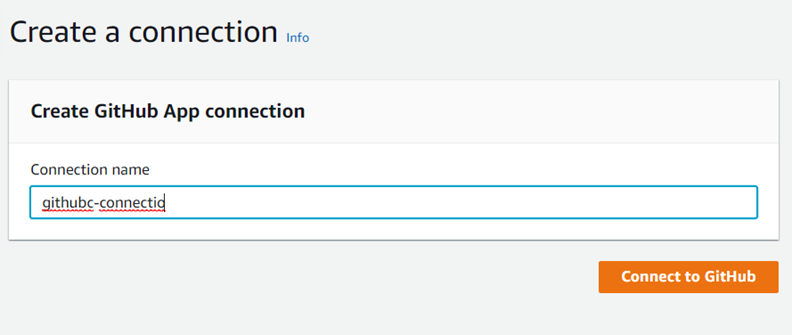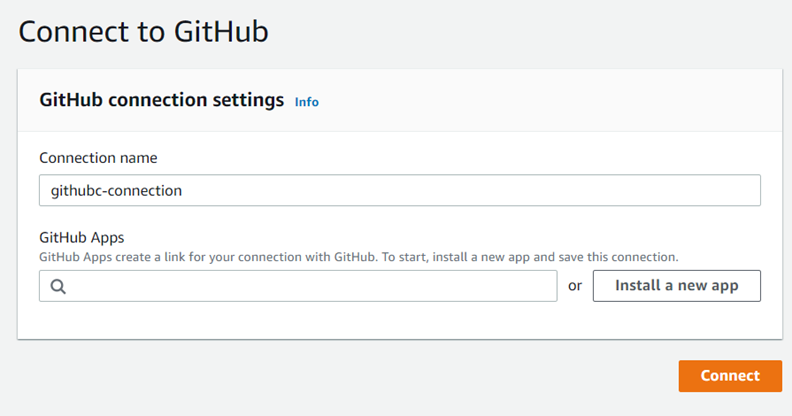GitHub connections
You use connections to authorize and establish configurations that associate your third-party provider with your AWS resources.
Note
Instead of creating or using an existing connection in your account, you can use a shared connection between another AWS account. See Use a connection shared with another account.
Note
This feature is not available in the Asia Pacific (Hong Kong), Asia Pacific (Hyderabad), Asia Pacific (Jakarta), Asia Pacific (Melbourne), Asia Pacific (Osaka), Africa (Cape Town), Middle East (Bahrain), Middle East (UAE), Europe (Spain), Europe (Zurich), Israel (Tel Aviv), or AWS GovCloud (US-West) Regions. To reference other available actions, see Product and service integrations with CodePipeline. For considerations with this action in the Europe (Milan) Region, see the note in CodeStarSourceConnection for Bitbucket Cloud, GitHub, GitHub Enterprise Server, GitLab.com, and GitLab self-managed actions.
To add a source action for your GitHub or GitHub Enterprise Cloud repository in CodePipeline, you can choose either to:
-
Use the CodePipeline console Create pipeline wizard or Edit action page to choose the GitHub (via GitHub App) provider option. See Create a connection to GitHub Enterprise Server (console) to add the action. The console helps you create a connections resource.
Note
For a tutorial that walks you through how to add a GitHub connection and use the Full clone option in your pipeline to clone metadata, see Tutorial: Use full clone with a GitHub pipeline source.
-
Use the CLI to add the action configuration for the
CodeStarSourceConnectionaction with theGitHubprovider with the CLI steps shown in Create a pipeline (CLI).
Note
You can also create a connection using the Developer Tools console under Settings. See Create a Connection.
Before you begin:
-
You must have created an account with GitHub.
-
You must have already created a GitHub code repository.
-
If your CodePipeline service role was created before December 18, 2019, you might need to update its permissions to use
codestar-connections:UseConnectionfor AWS CodeStar connections. For instructions, see Add permissions to the CodePipeline service role.
Note
To create the connection, you must be the GitHub organization owner. For repositories that are not under an organization, you must be the repository owner.
Create a connection to GitHub (console)
Use these steps to use the CodePipeline console to add a connections action for your GitHub or GitHub Enterprise Cloud repository.
Note
In these steps, you can select specific repositories under Repository Access. Any repositories that are not selected will not be accessible or visible by CodePipeline.
Step 1: Create or edit your pipeline
-
Sign in to the CodePipeline console.
-
Choose one of the following.
-
Choose to create a pipeline. Follow the steps in Create a Pipeline to complete the first screen and choose Next. On the Source page, under Source Provider, choose GitHub (via GitHub App).
-
Choose to edit an existing pipeline. Choose Edit, and then choose Edit stage. Choose to add or edit your source action. On the Edit action page, under Action name, enter the name for your action. In Action provider, choose GitHub (via GitHub App).
-
-
Do one of the following:
-
Under Connection, if you have not already created a connection to your provider, choose Connect to GitHub. Proceed to Step 2: Create a Connection to GitHub.
-
Under Connection, if you have already created a connection to your provider, choose the connection. Proceed to Step 3: Save the source action for your connection.
-
Step 2: Create a connection to GitHub
After you choose to create the connection, the Connect to GitHub page appears.

To create a connection to GitHub
-
Under GitHub connection settings, your connection name appears in Connection name. Choose Connect to GitHub. The access request page appears.
-
Choose Authorize AWS Connector for GitHub. The connection page displays and shows the GitHub Apps field.

-
Under GitHub Apps, choose an app installation or choose Install a new app to create one.
You install one app for all of your connections to a particular provider. If you have already installed the AWS Connector for GitHub app, choose it and skip this step.
Note
If you want to create a user access token
, make sure that you've already installed the AWS Connector for GitHub app and then leave the App installation field empty. CodeConnections will use the user access token for the connection. -
On the Install AWS Connector for GitHub page, choose the account where you want to install the app.
Note
You only install the app once for each GitHub account. If you previously installed the app, you can choose Configure to proceed to a modification page for your app installation, or you can use the back button to return to the console.
-
On the Install AWS Connector for GitHub page, leave the defaults, and choose Install.
-
On the Connect to GitHub page, the connection ID for your new installation appears in GitHub Apps. Choose Connect.
Step 3: Save your GitHub source action
Use these steps on the Edit action page to save your source action with your connection information.
To save your GitHub source action
-
In Repository name, choose the name of your third-party repository.
-
Under Pipeline triggers you can add triggers if your action is an CodeConnections action. To configure the pipeline trigger configuration and to optionally filter with triggers, see more details in Add trigger with code push or pull request event types.
-
In Output artifact format, you must choose the format for your artifacts.
-
To store output artifacts from the GitHub action using the default method, choose CodePipeline default. The action accesses the files from the GitHub repository and stores the artifacts in a ZIP file in the pipeline artifact store.
-
To store a JSON file that contains a URL reference to the repository so that downstream actions can perform Git commands directly, choose Full clone. This option can only be used by CodeBuild downstream actions.
If you choose this option, you will need to update the permissions for your CodeBuild project service role as shown in Add CodeBuild GitClone permissions for connections to Bitbucket, GitHub, GitHub Enterprise Server, or GitLab.com. For a tutorial that shows you how to use the Full clone option, see Tutorial: Use full clone with a GitHub pipeline source.
-
-
Choose Next on the wizard or Save on the Edit action page.
Create a connection to GitHub (CLI)
You can use the AWS Command Line Interface (AWS CLI) to create a connection.
To do this, use the create-connection command.
Important
A connection created through the AWS CLI or AWS CloudFormation is in PENDING
status by default. After you create a connection with the CLI or AWS CloudFormation, use the
console to edit the connection to make its status AVAILABLE.
To create a connection
-
Open a terminal (Linux, macOS, or Unix) or command prompt (Windows). Use the AWS CLI to run the create-connection command, specifying the
--provider-typeand--connection-namefor your connection. In this example, the third-party provider name isGitHuband the specified connection name isMyConnection.aws codestar-connections create-connection --provider-type GitHub --connection-name MyConnectionIf successful, this command returns the connection ARN information similar to the following.
{ "ConnectionArn": "arn:aws:codestar-connections:us-west-2:account_id:connection/aEXAMPLE-8aad-4d5d-8878-dfcab0bc441f" } -
Use the console to complete the connection. For more information, see Update a pending connection.
-
The pipeline defaults to detect changes on code push to the connection source repository. To configure the pipeline trigger configuration for manual release or for Git tags, do one of the following:
-
To configure the pipeline trigger configuration to start with a manual release only, add the following line to the configuration:
"DetectChanges": "false", -
To configure the pipeline trigger configuration to filter with triggers, see more details in Add trigger with code push or pull request event types. For example, the following adds to the pipeline level of the pipeline JSON definition. In this example,
release-v0andrelease-v1are the Git tags to include, andrelease-v2is the Git tag to exclude."triggers": [ { "providerType": "CodeStarSourceConnection", "gitConfiguration": { "sourceActionName": "Source", "push": [ { "tags": { "includes": [ "release-v0", "release-v1" ], "excludes": [ "release-v2" ] } } ] } } ]
-